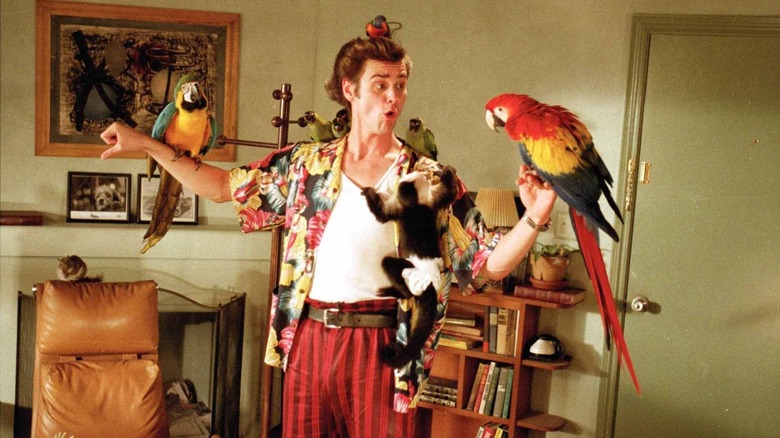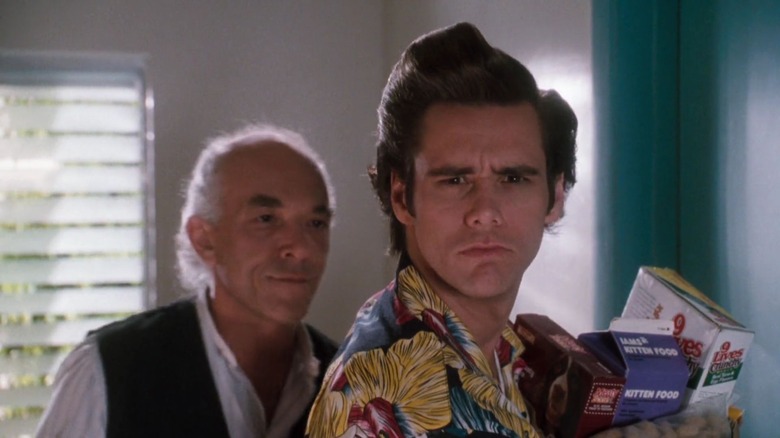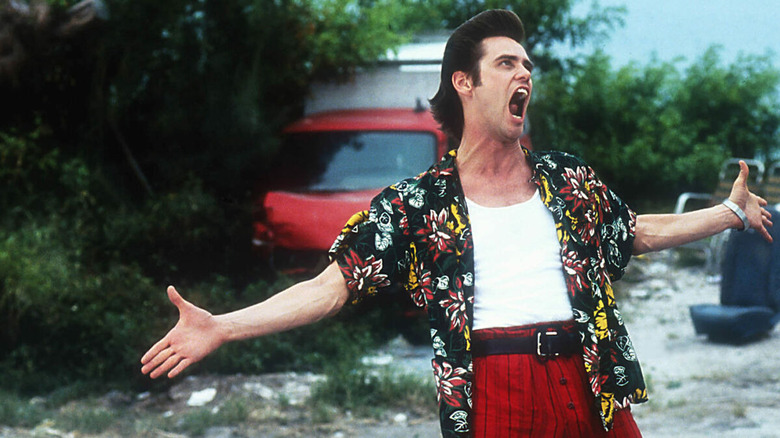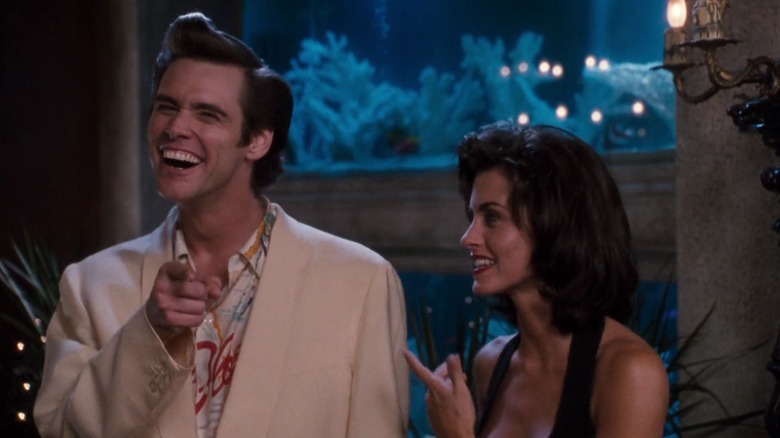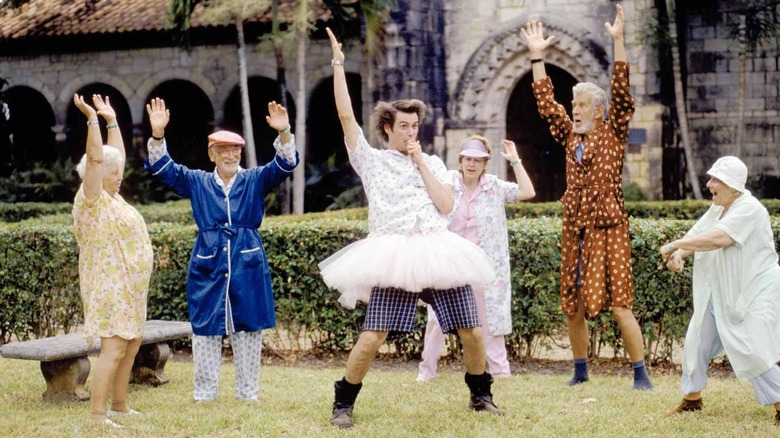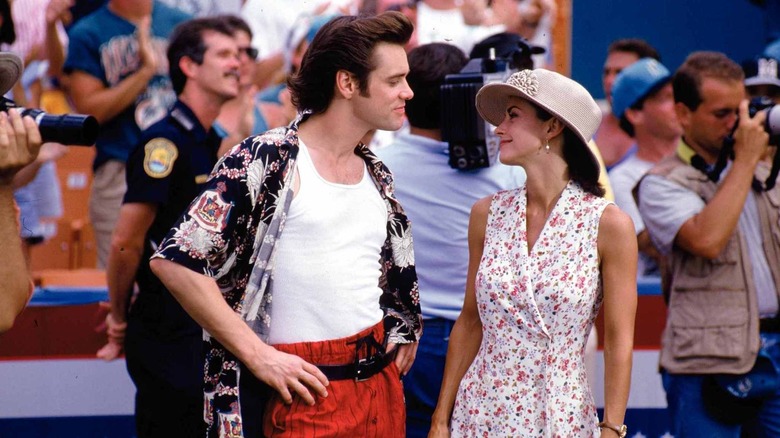Ace Ventura: Pet Detective Made Jim Carrey A '90s Box Office Phenomenon
(Welcome to Tales from the Box Office, our column that examines box office miracles, disasters, and everything in between, as well as what we can learn from them.)
"If you went into a movie called 'Ace Ventura: Pet Detective' and you were doing the stuff I was doing in that movie, would you be expecting while you were doing that movie that it was going to be huge?" Jim Carrey asked this to radio shock-jock Howard Stern in 1994 shortly after the actor's movie opened unexpectedly atop the box office. Stern bluntly responded with "No" but it was, in fact, a monster hit. It was one of three such hits that Carrey would be a part of that year, making it one of arguably the best years that any actor has had — from a commercial standpoint — in history.
Yet, it all started with a movie that, as Stern pointed out, "must have been the worst script ever written on the planet Earth." While it might be difficult now since the character of Ace Ventura became a defining figure in '90s pop culture (thanks almost entirely to Carrey's performance), it is easy to see how, on the page, this seemed like a disaster waiting to happen that was destined for bargain bin status right alongside other failed films of the era such as "Joe's Apartment" and Carrot Top's "Chairman of the Board." Instead, it became an unlikely springboard for a ridiculously fruitful career, kicking off one of the greatest runs in the history of movie stardom.
In this week's Tales from the Box Office, in honor of the movie's 30th anniversary, we're looking back at "Ace Ventura: Pet Detective." We'll look at how Carrey landed the role, how he dramatically influenced the script, the doubts critics (and even members of the crew) had ahead of the film's release, what happened when it hit theaters, and what lessons we can learn from it all these years later. Let's dig in, shall we?
The movie: Ace Ventura: Pet Detective
Morgan Creek's chairman and CEO James G. Robinson wanted to make a broad comedy with mass appeal. The company had previously released movies like "Young Guns" and "True Romance," but the idea here was to connect with general moviegoers. Robinson's directive would prove to be ridiculously lucrative for the studio. They settled on "Ace Ventura: Pet Detective," which was originally written by Jack Bernstein, though his version differed greatly from what would eventually make its way to screen.
The film as we know it centers on Ace Ventura (Carrey), an animal detective who is tasked with finding an abducted dolphin named Snowflake, the mascot of the NFL's Miami Dolphins. First-time director Tom Shadyac was chosen to occupy to the director's chair and he would rewrite Bernstein's screenplay, but he would need the help of the eventual star. This movie was not originally written for Carrey, even if the end product feels as though it were. In fact, he was far from the studio's top choice for the role. It's only because several other avenues didn't pan out that the project wound up on his desk. Carrey was, at that time, best known for his role on "In Living Color" and was not by any means a bankable movie star.
It was the legendary Rick Moranis ("Spaceballs") who was the studio's top choice, but he ultimately passed. Judd Nelson ("The Breakfast Club"), Alan Rickman ("Die Hard"), and even possibly Whoopi Goldberg ("Sister Act") were considered the lead role before Carrey was approached. Once Carrey signed on, things began to take shape.
The 007 of pet detectives
Carrey ended up heavily rewriting the script with Shadyac, so much so that the actor also received a screenwriting credit. He was also free to improvise a lot on set, offering him a great deal of influence over the film's direction. Speaking in 1994 while the film was in the middle of its theatrical run, Carrey explained that he had a very clear vision for the character, knowing that it was a risky way to approach the project.
"I knew this movie was going to either be something that people really went for, or it was going to ruin me completely. From the beginning of my involvement, I said that the character had to be rock 'n' roll. He had to be the 007 of pet detectives. I wanted to be unstoppably ridiculous, and they let me go wild."
The performance at the center of the film is, indeed, unstoppably ridiculous. From talking out of his butt to catching a bullet with his teeth, Ace Ventura was a cartoon character brought to life in an otherwise normal version of the world we all exist in. Even when it came to the film's transphobic moments (which have dated the film greatly), Carrey knew that he was going to upset some people. Sean Young plays Einhorn in the movie, a cop revealed to be a former NFL kicker who cost the Dolphins a big game. In that same interview, he explained:
"I wanted to keep the action unreal and over the top. When it came time to do my reaction to kissing a man, I wanted it to be the biggest, most obnoxious, homophobic reaction ever recorded. It's so ridiculous it can't be taken seriously — even though it guarantees that somebody's going to be offended."
Other members of the crew were concerned that it was all a bit too much. "The stuff he was doing was so over the top," cinematographer Julio Macat said in reflection in 2019, "I truly thought [it] was gonna be the biggest piece of [expletive] ever."
The financial journey
Despite the concerns of personalities like Howards Stern and the filmmakers, Carrey's over-the-top antics were about to become a defining staple of '90s culture. Warner Bros. signed on to distribute "Ace Ventura," with the studio slotting the comedy on February 4, 1994. The film was released against terrible reviews (it holds a 48% approval rating on Rotten Tomatoes) and even though Courteney Cox was one of the leads, this was before "Friends" hit the airwaves. There was little reason to believe this was going to be a blockbuster hit. It became one anyway.
The movie opened atop the charts taking in $12.1 million on its opening weekend against a fairly modest $15 million production budget. That was just the very tip of the iceberg. It ended up coming in at number one in four out of its first five weekends in theaters, becoming a downright pop culture phenomenon. Critics be damned, it was a monster hit that turned Carrey into an overnight sensation.
"Ace Ventura" finished its run with $72.2 million domestically to go with $35 million internationally for a grand total of $107.2 million worldwide. Or, to put it another way, roughly seven times the movie's reported production budget. This is to say nothing of what the film brought in on home video and cable over the years. Unsurprisingly, a sequel was rushed into production in the form of "Ace Ventura: When Nature Calls." Warner Bros. managed to get it in theaters by November 1995, just 21 months after the first movie premiered. Despite earning even less favorable reviews, it pulled in a whopping $212.3 million worldwide. Even against a much larger $30 million budget, it was another mammoth success.
But let's not get too ahead of ourselves here. What Hollywood — and dare I say the world — was unprepared for was the rapid ascension of Jim Carrey in the public consciousness. That's because he had two other movies in the hopper that would help send him into the stratosphere in a matter of months.
Jim Carrey explodes as an A-list star
Fortunately for New Line Cinema, Carrey already had another big movie in the can in the form of "The Mask." Based on the Dark Horse Comics series of the same name and directed by Chuck Russell, the film was a visual-effects-heavy film that saw Carrey's character Stanley Ipkiss discover a magical mask that gave him cartoonish powers. It once again allowed the actor to deliver an all-out performance. It also had the added benefit of being Cameron Diaz's cinematic coming-out party as well, which set it up to be a huge hit.
"The Mask" opened in July and, much like "Ace Ventura" before it, topped the charts. It was an even bigger hit, taking in an astonishing $351.5 million worldwide against a $23 million budget. It made a fortune and to this day ranks as one of the actor's highest-grossing films. And yet, Carrey still had another trick up his sleeve in '94 as "Dumb and Dumber" (also hailing from New Line) hit theaters on December 16 of that year to give the actor three number one movies in less than 11 months.
Because of the success of "Ace Ventura," Carrey was able to negotiate a monster $7 million payday for "Dumb and Dumber," which was 20 times what his co-star Jeff Daniels was paid. It was money well spent as the film earned $247 million against a $17 million budget. But had the studio ponied up the $350,000 that Carrey originally wanted, they could have had the biggest star in the world at that moment for a bargain. Instead, he got more than 40% of the film's total budget.
In the years that followed, Carrey starred in a string of hits including 1995's "Batman Forever" ($336 million worldwide), "Liar Liar" ($302 million worldwide), "The Truman Show" ($264 million worldwide), "How the Grinch Stole Christmas" ($347 million worldwide), and "Bruce Almighty" ($484 million worldwide).
The lessons contained within
Yes, there were misfires like "Man on the Moon" but, overall, it's one of the most impressive runs any actor has ever had or ever will have. The actor's films have collectively grossed nearly $6 billion worldwide and he's still starring in hits such as "Sonic the Hedgehog" a full three decades after his breakout role as a wacky pet detective. Few movie stars will ever achieve this level of success. Moreover, even those who are lucky enough to ascend so rarely do so by existing on their own terms as a singular performer.
In reflection, it's worth marveling at what Carrey was able to do with what was on the page. It would have been so easy to snub your nose down at a silly movie about a pet detective, take the check, and hope for the best. Instead, he saw an opportunity to truly do something with the material and, though critics might disagree, he created a comedy classic that has endured. On the back of that film, he built a career the likes of which we might never see again. Theatrical comedy isn't what it once was and, more than that, Hollywood seems to have trouble making new movie stars of any kind. Tom Cruise is maybe the last true blue movie star we have in some ways.
Sure, maybe this movie would have worked with Rick Moranis. I imagine a lot of people would like to see that version of it. But in giving the role to Jim Carrey, a new movie star was born. Heck, broader popular culture was altered through this actor's classic performances. So sure, Hollywood can keep bleeding aging movie stars dry but if there's one lesson to be learned from this movie 30 years removed, it's that taking chances on new stars is worth it.
The real Jim Carrey won't be here forever, and the next Jim Carrey is out there somewhere. Hollywood just needs to give them the breakout role they deserve.
